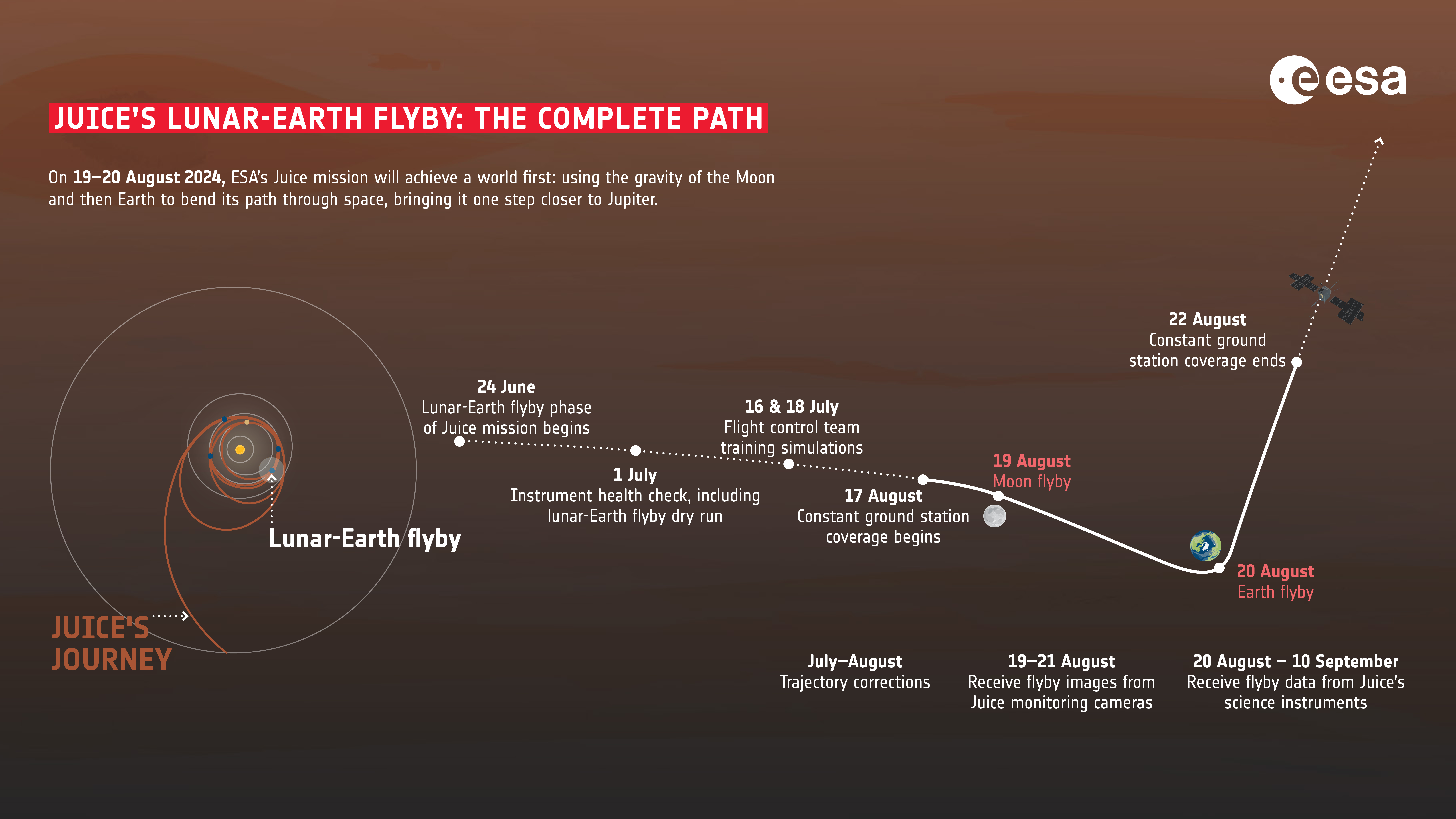In a matter of days, the European Space Agency’s JUICE mission will attempt a completely new maneuver that breaks two records: It will be the first time a spacecraft uses two objects for a gravity assist maneuver, and it will be the first-ever Lunar-Earth flyby. The Lunar-Earth Gravity Assist (LEGA) is expected to save JUICE a lot of propellant, which will be used later in the mission.
It is a daring maneuver. First thought of 15 years ago, it requires launching the spacecraft at a precise second so that it will find the Moon and the Earth in the right position. It will first go by the Moon in the evening of Monday 19 at 21:16 UTC, losing some of its speed. It will then approach the Earth about 25 hours later. Our planet will slow it down further and send it on its way to Venus – but there is no room for errors.
“It’s like passing through a very narrow corridor, very, very quickly: pushing the accelerator to the maximum when the margin at the side of the road is just millimeters.” Spacecraft Operations Manager, Ignacio Tanco, said in a statement.
The slowing down part might seem counter-intuitive – it ought to get faster if we want it to send it all the way to Jupiter, right? But celestial mechanics is a game of give and take, and the more you can coast by stealing speed from planets, the more fuel you will have later during the mission as you do not have to use it in transit.
The recent and upcoming movements of JUICE in the Earth-Moon system.
Image Credit: ESA
The LEGA is such a clever shortcut to get to Jupiter that it will allow a whole new portion of the mission to be opened to the spacecraft. JUICE will be studying the icy moons of Jupiter, and after many flybys, it will enter orbit around the largest moon in the solar system: Ganymede
“It’s a very important mission because we want to find out whether there are habitable places inside the icy moons, so Europa, Ganymede, or Callisto. That’s the main question of the mission,” Dr Olivier Witasse, a planetary scientist working on the scientific aspects of the mission, previously told IFLScience.
Thanks to the fuel saved by this maneuver, the team expects they’ll be able to orbit at just 200 kilometers (120 miles) from the surface of Ganymede, allowing the spacecraft to conduct even more precise observations. This flyby will help not just get the spacecraft in the right orbit and speed but also to make sure the instruments are working well.
The Moon is the only object with a negligible atmosphere that JUICE will pass near before getting to Jupiter. So during the flyby, a whole set of instruments will be tested using the Moon and then Earth.
“This could not be done in the lab. This will be an excellent test to check the performance of the radar in the context of the full spacecraft operating,” Nicolas Altobelli, planetary scientist with ESA, said during a press conference attended by IFLScience.
To study the potential ocean underneath the thick icy crust of Ganymede, JUICE will have multiple instruments including a three-in-one tool that will measure the gravity of the distant Moon. We asked about the experts if it will be fully tested during the flyby but only part of it will be.
“We will use the accelerometer on board of the spacecraft to perform some tests,” Dr Altobelli confirmed. His colleague, Juice Science Operations Scientist Dr Claire Vallat, provided further insights: “We will not do a gravitational field measurement like we will do in the Jupiter system, as we will not be using the Ka transponder but, as Nico mentioned, the High Accuracy Accelerometer will be on and we will provide some valuable information on the lunar gravity gradient.”
The space stage is set. Now, it’s just the question of nailing this maneuver and sending JUICE flying towards Venus. It will go past the planet in August 2025 before coming back to Earth, first in September 2026 and then in January 2029. Those final flybys will give it enough speed to get to Jupiter in July 2031, studying the system for 3 years, before orbiting Ganymede alone.
Source Link: This Month ESA Will Attempt Something Never Tried Before – The First Lunar-Earth Flyby
